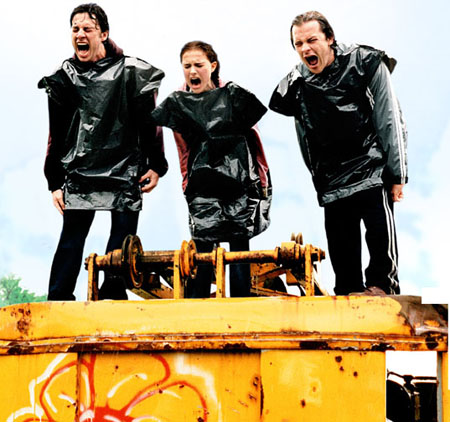You are currently browsing Quinn Reid’s articles.
Recently I re-watched the 2004 movie Garden State, written, directed, and starred in by Zach Braff of Scrubs fame. I hadn’t seen it for years, and hadn’t remembered a lot about it except that I had enjoyed it a lot. Seeing it again, my enjoyment was confirmed, but I realized why it was hard to remember much of anything about it: it doesn’t seem to have a plot.
The movie starts by introducing Andrew. A plane is going down, and everyone on the plane is screaming and crying and praying except for Andrew, who looks kind of distracted and tired. The snack cart tumbles down the aisle toward us. Andrew adjusts the little airflow thing above his seat. We think, what the f*ck is wrong with this guy?

That question looms large for most of the movie, soon accompanied by is he ever going to pull himself out of this zombie existence? It’s a strangely riveting question, and it takes a very long time for the answer to develop. Whether or not he’s going to be able to emerge and actually start feeling something–and what will happen to him if he does–makes up a story arc that takes us from the very first moment of the movie to the very last. But a single story arc doesn’t generally keep us interested for that long if there aren’t smaller-scale things to interest us along the way.
In this case, the smaller-scale things are what I would describe as gradually escalating weirdness–weirdness that in some ways gets more comforting as it gets stranger. I certainly wouldn’t have imagined that such an approach could possibly be adequate to keep interest and enjoyment up in a movie, but (at least for me), boy does it. I think the “comforting” part is important, too: weirdness for its own sake, or disturbing weirdness, wouldn’t serve the same purpose at all.
One thing the movie does marvelously and uses to contribute to this gradually increasing weirdness is introduce characters, one after the other, who are sharply defined and immediately engaging–and for the most part these are throwaway characters, people who delight us in three minutes of screen time and then are gone. From Kenny the obnoxious-partier-turned-policeman to the Medieval Times knight who’s dating his friend’s mother to the guy whose job is to make sure no one interferes with a vast chasm hidden in a junkyard, and on and on. Watching this movie, you get the idea that the world is populated with strange and fascinating people, places and moments, all of which keep getting stranger and more fascinating the more you look around. And this process of gradually escalating weirdness, while it’s just plain fun, also seems to bring us along on Andrew’s journey of waking up. The world seems more and more alive as the movie progresses.
So there is a plot, although a strange one. It helps significantly that we slowly get a series of unexpected revelations about why Andrew is the way he is in the first place, so that the same plot is simultaneously going backwards to the source and forwards to how things turn out.
The more I consider the structure of this movie, the more annoyed I am at Zach Braff. He’s already quite a good actor: is it really necessary for him to horn in on my favorite art (writing), especially in such an effective way?
My guess is that Braff was not trying to follow prescribed principles of story structure, but rather only his own passions and interests. I could be wrong: maybe there’s a way to actually plan a movie like this by thinking about three-act structure and story arcs and scene and sequel and other techniques. Certainly any number of magnificent stories have been written with those principles in mind. Ultimately, though, the life in the story seems to come from a marvelous tension between pain and joy, between turning away and leaping in.

